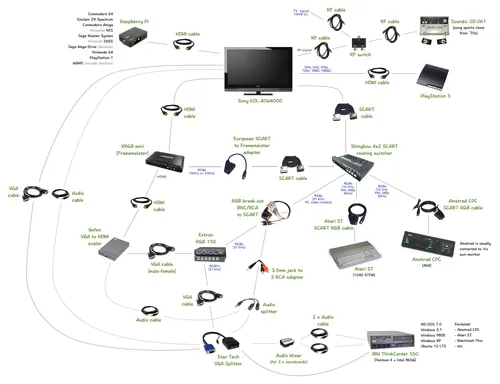The (crazy) video/audio processing set-up
Here’s the setup of my video and audio signal traversal and processing on one corner of my retro cavern.

The idea is that under limited space constraints I would get a best possible “retro” image quality from multiple devices connected to just one LCD TV. With this setup, it is also possible to “route” image to the display through multiple paths and manage the tradeoffs between image quality, input lag and “number of buttons pressed using five remote controllers”.
The reason a modern setup like mine is a bit “crazy” is the fact that you may get a better experience using old hardware. A gaming console connected to a ray tube TV always give you zero-lag performance and visuals that are not too crisp or pixellated. Also, some gear on this setup is not exactly cheap, so if you want something like this, you will use your possibly limited retro collecting budget on new hardware. On a more positive note, you can save a lot of physical space, perceive more vibrant colors, enjoy huge screen estate and have a lot of fun building it.
The major component of my setup is XRGB-mini aka. Framemeister. This little device does great work on transposing old school analog video signal to a modern telly. My TV is a Sony from 2008, and unlike many new LCD TVs, it happily takes in 240p signal (from Atari ST and Amstrad CPC). With Framemeister, I can possibly get greater video quality, and enjoy some visual tricks (e.g. zoom it and simulate a CRT-look using scanlines). Using Framemeister with PC video standards was also something I wanted to achieve, and it ended up being quite a challenge. In the end, I managed to get a “CRT-like” look using scanlines when playing DOOM under real MS-DOS.
There are some issues when digitally processing video signals, and the situation gets worse when there is more than just one processing point for the signal. One annoying one is your video processors will introduce some input lag. How much lag truly influences your gaming experience is controversial, and whatever you do, there is always some lag between you pressing the fire button and seeing an action on the screen. Unfortunately, Framemeister introduces rather considerable lag (about 1,5 frames or 20 ms), but as my TV has (close to) zero lag on full-HD mode, the total lag should still be more or less unnoticeable. I haven’t measured the lag my Sony introduces when internally scaling 240p signal, so it is possible that Framemeister actually does the processing faster and the total lag, therefore, could even be reduced.
I might later blog about the lag, video quality, using Framemeister, scanlines and how to get Framemeister working with VGA-signal.
